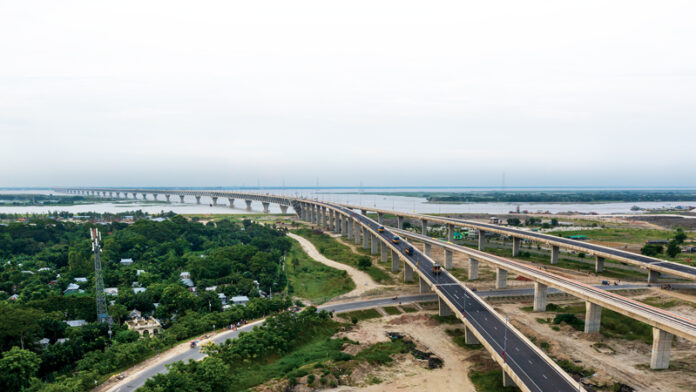“The Padma Bridge belongs to the people of Bangladesh. It involves our passion, our creativity, our courage, our endurance, and our perseverance.” – On 25 June 2022, when she opened the country’s longest bridge, the Honorable Prime Minister Sheikh Hasina made this remark
Introduction
For decades, people of the south and south-western region of the country have yearned for a bridge over the Padma River. Those days are over now. The bridge, connecting Mawa-Jazira point, is not only an answer to the craving of the people of the south, but also a testament for the world that says, no matter what, Bangladesh’s self-esteem should never be underestimated. Today, the Padma Bridge stands tall and bright atop the dancing waves of the ever-flowing Padma , as the hallmark of our glory, the emblem of our capability.
Grave necessity, great invention
The Padma River greatly influences Bengal’s topography. The economic growth of the Gangetic alluvium-formed delta depends heavily on this river as well. Its rich history in culture and trade is well known. The sediments it carries have helped the development of our agricultural industry. However, there is the other side to the story as well. The mighty Padma divides the southern region of the country from its capital Dhaka. This has created a glaring gap in the economic prosperity between the two sides of the Padma.
To bridge the gap, the Padma Bridge will serve as a gargantuan installation linking those regions with Dhaka and Chattogram. Economists believe this will accelerate the overall GDP growth of the country. The South and South-West regions’ gross domestic product will also increase. Moreover, this bridge will play a significant role in local communication development. Thanks to the rail connectivity, transporting goods across the Padma will be simpler and less expensive.
Hence, the inauguration of the Padma Bridge is being mentioned by many as the ‘opening of the southern door’. Undeniably, this bridge has opened new horizons of possibilities for the national economy of Bangladesh.
Biggest piece of the puzzle in road and rail connectivity
A total of 1.7 million square kilometres are covered by the Ganga, Jamuna, and Meghna river basins, which are located in Bangladesh, India, China, Nepal, and Bhutan. The Ganga or Padma basin, with an area of over 1.1 million square kilometres, is the largest of them. With 4% of it in Bangladesh, the most of it is in India and Nepal.
Padma River is the name of the Indian Ganga River that flows through Bangladesh before reaching the Bay of Bengal. It is the major Ganges stream that starts in the Himalayas from the Gangotri glacier. From its source, the river travels 2,520 kilometres before joining the Bay of Bengal. The Padma River takes its name from the Chapainawabganj district, where the Ganga River enters Bangladesh. It passes through Rajshahi, Pabna, Kushtia, and Rajbari in Bangladesh before joining the Jamuna at Daulatdia. This combined stream then conjoins the Meghna River near Chandpur, which flows into the Bay of Bengal.
The Padma River used to be powerful, majestic, and terrifying. It was once considered impossible to harness this river so that a bridge could be built. Even two or three decades ago, it was impossible for us to envisage a situation where we could avoid river’s unpredictable behaviour for riverbank communication.
Due to its enormous size, Padma is referred to as “Mighty River.” Standing on one side of the river in some locations makes it impossible to see the opposite side. And everyone is aware of how devastating the Padma River is during the monsoon. The Padma River is claimed to get the second-highest volume of water after the Amazon River. River current velocities can reach 4 to 4.5 metres per second during the height of the monsoon.
The Padma is still strong and deep downstream from Goalondo in Rajbari, despite some upstream weakening over time. As a result, getting across this river posed a significant barrier to uninterrupted connectivity between the southern and southwestern portions of the country and the centre, northeastern, and southeast regions. Ferries, launches, speedboats, and other river-based watercraft were frequently disrupted by severe rainstorms or thick fog.
The three rivers Padma, Jamuna, and Meghna split Bangladesh’s area into three major regions. Eastern part includes Chittagong and Sylhet divisions, Central part with Dhaka and surrounding districts, and Western part with Rajshahi, Rangpur, Khulna, and Barishal. Following Bangladesh’s independence, road connectivity has progressively improved. Direct road connectivity between various regions of the country has been established by Meghna Bridge, Meghna-Gomti Bridge, Bangabandhu Multipurpose Bridge over Jamuna, Lalon Shah Bridge over Padma in Pakshi, Shah Amanat Bridge over Karnaphuli in Chattogram, Rupsha Bridge in Khulna, Payra Bridge in Patuakhali, and Bhairab Bridge. The opening of Padma Bridge furthered that initiative’s success by completing the necessary developments.
The grandest opening ceremony since independence
The entire nation turned into a celebratory mode the day the Padma Bridge officially commenced its service. The Honourable Prime Minister Sheikh Hasina unveiled a plaque at the Mawa end of the Padma Bridge on that day at 11:58 AM. Prior to it, she spoke at a civil society audience. Cabinet Secretary Khandkar Anwarul Islam welcomed everyone to the congregation, that was presided over by Minister of Road Transport and Bridges Obaidul Quader.
The Prime Minister issued commemorative stamps, souvenir sheets, ceremonial envelopes and seals, as well as commemorative notes worth BDT 100, to mark the opening of the Padma Bridge. Major Bridge Engineering Company Limited (MBEC) of China, the construction company behind the bridge presented the Prime Minister with a miniature replica of the Padma Bridge.
Padma Bridge and China
The Padma bridge is so far the largest bridge Chinese companies had ever built outside China. The Chinese and local engineers of the project had to overcome the “unforeseeable physical conditions”, figure out the actual parameters in the river and then complete and modify the design, which took almost 2 years. The project involves 13 Chinese technologies which have never been used in the world, so the whole project was full of experiments that nobody had ever made before. Besides, the unique hydrographic features of the Padma River also posed the most daunting challenge for construction. The sand and soft clay at the bottom of the river wasn’t stable enough to provide the required support to the pillars, so the steel piles had to be driven 120 metres deep into the river bed. Five state-of-the-art hydraulic pile hammers from China, including the largest one in the world, were deployed. Moreover, the bridge has become an integral part of BCIM (Bangladesh, China, India, Myanmar) corridor.
Economic potential of Padma Bridge
The Padma Bridge would initially accommodate 8,000 vehicles daily on average. The number will progressively increase. According to the feasibility study, 41,000 vehicles will cross the bridge daily in 2025 as a result of the growth of industries over the next three to four years and the opening of additional mass transportation routes.
Mongla Port and Dhaka today are much closer by road, thanks to the opening of the Padma Bridge. As a result, more commodities are being imported and exported through the port in containers. Since the Padma Bridge was opened, the port is now be able to handle the increasing pressure by utilising the major portion of its handling capacity that was previously left idle for container handling. But in the future, this pressure will undoubtedly rise. Therefore, efforts are being made to improve the Mongla Port’s capacity.
According to the Mongla Port Authority, it plans to increase the handling capacity up to 800,000 containers annually by 2025. For this, building of a new terminal is currently underway on a public-private partnership (PPP). The quantity of port equipment has also increased. Dredging is also going on in full swing.
Currently, Mongla Port imports the majority of the vehicles. This has further increased since the bridge began operation. Thanks to the Padma Bridge, delivery of automobiles to the buyers now takes less time, encouraging vehicle importers to use the port to a greater extent.
The Payra Port’s first container terminal will be finished by the end of the next year. Container vessels will be able to berth at the port jetty once the terminal begins functioning. The import and export of raw materials for various sectors would be made easier.
The container terminal currently under-construction would be able to handle three container vessels simultaneously. The terminal would also revitalise Payra Port’s operational activities. In order to fully utilise the bridge, the Payra Port Authority is preparing itself, by conducting dredging works and others, to accommodate vehicle-importing vessels at the port’s service jetty from September instant.
The consultancy firm for the Padma Bridge predicts that in the first year, the bridge will generate BDT 14.3 billion in income and after 35 years, the bridge will generate more than BDT 900 billion. The Bridge Authority has signed a financing agreement with the Ministry of Finance based on this prediction.
According to the feasibility study report, the expansion of trade in the south and southwest of the country will increase the GDP growth rate of the country by 1.23%. And the GDP growth in the south and southwest will rise to 2.3%. Increasing contribution to GDP will naturally help poverty alleviation. According to another report by Asian Development Bank (ADB), the poverty reduction rate will increase 0.84% with the blessings of the Padma Bridge.
Presently, there are eight export processing zones (EPZ) and an economic zone operating in the country. Of these, only Mongla EPZ is located on the other side of Padma. Two more EPZs in Jashore and Patuakhali are being planned to utilise the connectivity support from the Padma Bridge. Once these are constructed, the export -oriented sector will also create huge opportunities of employment for the people.
There are also plans to build four economic zones in Mongla Port, Gopalganj, Madaripur, and Payra Port, according to sources in the Bangladesh Economic Zone Authority (BEZA). In Gopalganj and Faridpur, two industrial cities are being developed. A hand-loom village is also being built in Madaripur. By attracting tourists to visit the Sundarbans, Kuakata, and other popular tourist destinations in the south and southwest of Bangladesh, the Padma Bridge will also help boosting of the country’s tourism industry.

Multimodal connectivity will increase
The rail network seems to be the major solution for communication that is secure, quick, and affordable. The railway communication system is crucial for the movement of commodities. On Padma Bridge, train service is anticipated to begin in the first half of 2023. Besides the Rupsha Rail Bridge, another enormous structure in country, being constructed, a new railway line between Khulna and Mongla is also being built. Direct rail connectivity will be established between Mongla Port and Dhaka and Chittagong Port once the construction is complete and the Padma Bridge’s railway connection becomes operational. The pace of the nation’s import-export trade will significantly increase by this multimodal connectivity of roads and railways.
The construction of the Padma Bridge Rail Link will also allow Payra Port to join the multimodal connection. Connecting the greater Barishal region to the rail network has also been made possible by this bridge.
Benapole in Jashore is the largest land port in country. Up to this point, getting from Benapole to Dhaka and the adjacent areas had been exhausting due to the lengthy wait for the ferry and a time-consuming rail trip. Both issues are being resolved with the establishment of the Padma Bridge. In addition, the rail network will open up additional options for the delivery of commodities from Benapole land port. In that instance, import-export will be less expensive and take less time.
Padma Bridge will also play a special role in regional connectivity. It will be connected to Asian Highway AH-1. And the Trans-Asian Railway will be connected with the Padma Bridge Rail Link Project. As a result of this, direct communication will be established with various countries including India, Bhutan, Nepal. Besides, there are also plans to run direct trains from Singapore to Europe along the Trans-Asian network, Padma bridge will be an important part of it. This bridge will facilitate the transportation of goods through transit from Kolkata to Dhaka to the north-eastern states of India. As a result, the possibility of regional trade will increase.

Conclusion
The Padma Bridge is a brilliant illustration of Bangladesh’s economic potential. Along with foreign expertise, a sizable number of local engineers, officials, and employees participated in this project.
The second seaport in Bangladesh, Mongla Port, has recently been revamped. The import-export trade of the country can be enhanced by this port and the Pyara Port. These two ports can be used to transport goods from West Bengal to eastern India using transit facilities. The deep sea port in Cox’s Bazar, Matarbari, will serve as a sub-regional hub. At Chittagong Port, transit and transshipment have begun. Therefore, we can make use of our geographic location by connecting Mongla and Payra, where Padma Bridge can offer multimodal connectivity.
An indispensable factor in the advancement of the economy is improved connectivity. In order to see Bangladesh as a developed nation, according to the Prime Minister’s Vision-2041, we must improve our connectivity. The Padma Bridge’s opening marks a great leap towards realising that visionary goal.




